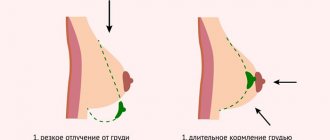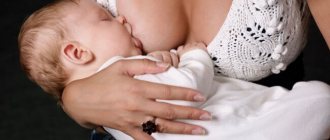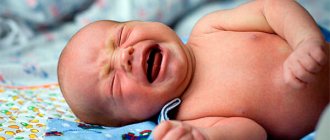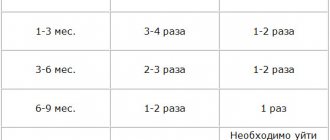Breastfeeding is the most natural and easiest way to provide nutrition to a newborn baby. Mother's milk protects the baby from infections, prevents the risk of developing food allergies, promotes the growth of healthy teeth and improves intellectual development. The process of breastfeeding is associated not only with the joy of motherhood, but also with some complications, especially in the first weeks after childbirth. Discomfort during feeding is considered quite normal, but severe pain, cracked and bleeding nipples are always a reason to consult a doctor. What Causes Soreness and Cracks During Breastfeeding? What should breast care be like for a nursing mother? Let's talk about this in our article.
Why do cracked nipples occur when breastfeeding?
Please note that many people attribute cracked nipples during breastfeeding to excessive dryness and unprepared nipples. Actually this is not true. Because almost all women have skin in this area that is equally delicate. It is not constantly exposed to air and does not rub against hard fabric. Accordingly, the skin on the nipples is very soft, tender and smooth. Any strong irritants can provoke the appearance of wounds.
Causes:
- However, it is worth noting that the main cause of cracked nipples is improperly organized breastfeeding. That is, the mother puts the baby to the breast incorrectly. Initially, the nipple itself should not be involved in the feeding process; it is necessary to apply it with the areola so that the baby’s lower lip covers the rim almost completely.
- If the baby attaches incorrectly, the baby grabs the nipple and chews it with his teeth, sucking the milk out. In fact, this is difficult not only for the mother, but also for the child, since this technique of sucking milk does not allow enough satiety. Because of this, the child is nervous, capricious, and the mother is forced to put him to the breast more often, thereby worsening the situation with the nipples.
- Many doctors, especially older ones, recommend washing your nipples with water and baby soap after each breastfeeding. This is wrong, because soap is alkaline and dries the skin very much, aggravating the situation with the nipples. There is no need to wash your breasts after each application. This is due to the fact that opportunistic microflora is present on everyone’s body, including in the corners of a child’s mouth. Accordingly, he will not suffer any harm if his immunity is normal.
Breast pump
What do cracks look like?
If the integrity of the nipple is damaged, the woman experiences a sharp pain radiating to the shoulder blades while feeding the baby . In addition to pain, the mother may experience itching, tingling, redness and heat in the breast area. Without proper treatment, the damaged areas may become infected and candidiasis or mastitis may develop.
The crack can extend deep into the nipple for a considerable distance. In the absence of therapy, the edges of the wound become denser, the vessels are compressed, and the elements of the lymphatic system become vulnerable to infections. From the outside, the wound looks like a “split” running from the center of the nipple to the side.
Such injuries are normal at the beginning of breastfeeding and disappear after a few days. But sometimes this does not happen for a number of reasons.
How to treat cracked nipples: mistakes in choosing a remedy
How can you cure cracked nipples? If, however, cracks have formed during breastfeeding, then you should not purchase silicone pads. Of course, this is the easiest way out, as it allows you to completely eliminate the baby’s contact with the nipple. However, after canceling these pads, problems arise again in weaning the baby to the breast. The fact is that such pads force the baby to grasp the breast incorrectly. Thus, after abandoning them, the baby continues to grasp the nipple incorrectly, which will again contribute to its traumatization.
The main task is to learn how to properly attach the baby to the breast. If this is your first child and you have no experience, try to find a lactation consultant in your city, or ask for advice from a friend who has successfully breastfed a child.
Breastfed
Doctor, what's the reason?
It would seem, what kind of pain can a small, just born child cause? He has little strength, no teeth or sharp nails, he is safe! But not for women's breasts. Delicate skin instantly reacts to the impact that the baby has when sucking on the breast. The baby has bare gums in his mouth, but he can use them to grab the nipple tightly, causing additional pain.
Experts talk about several reasons why cracked nipples or pain in the areola area appear.:
- The baby latches onto the breast incorrectly and puts too much pressure on the delicate skin with his gums. If a newborn is not taught to suckle normally, he will continue in the same spirit. With proper breastfeeding, painful sensations appear after 20 minutes of continuous process, and if you ignore the rules of breastfeeding, after just a couple of minutes the woman will begin to hiss in pain and beg the baby to eat faster, the process will resemble torture, and not the sacrament of unity of mother and child. If it is painful for a woman to feed her baby for a long time, she will try to pull the breast out of his mouth. But this is a lost cause, babies don’t want to give away food, so they cling to the skin of the nipple with their gums so that you can howl. And if there were already cracks, then feeding becomes unbearably painful.
- Insufficient breast hygiene. Some mothers believe that baby's saliva is harmless and does not need to be washed off after feeding. But in fact, this creates an ideal environment for the development of bacteria that will cause inflammation in the cracks.
- Excessive hygiene. Not washing your breasts is bad, but you shouldn’t rub yourself too thoroughly with soap, antiseptics, or shower gels. If the mother is worried that bacteria from the nipples will get into the baby's mouth, disaster will not happen and the baby's body will cope with the attack. In addition to exposure to hygiene products, a woman can re-injure her skin when washing, and soapy water will get into the cracks, causing pain and burning.
- Features of the mother's skin. If a woman constantly feels that her skin is drying out and has to be lubricated with moisturizer, then you should not think that the situation with the nipples will be better. Insufficient hydration leads to cracks, and with constant mechanical damage, you should not hope for pleasant sensations.
- If a child develops symptoms of candidiasis, the fungi will quickly migrate to the mother’s body, feeling comfortable in the damaged skin and multiplying there.
- A lack of vitamin A, required for normal skin regeneration, leads to cracking and reduces the likelihood of normal healing.
- A poor-quality breast pump or improper use of the device can cause cracks and microscopic damage to the nipple and the skin around it.
It is necessary to treat cracked nipples that appear during feeding, taking into account the root of all problems. It is impossible to constantly use a healing cream, but continue to incorrectly attach the baby to the breast or abruptly interrupt feeding. Before starting therapy, you need to understand whether the pain really arises from cracks?
Cracked nipples: treatment with Bepanten
The safest remedies to help cope with cracked nipples: Bepanten, geranium essential oil, sea buckthorn oil, and Lanolin. All of these products are safe, some of them do not even need to be washed off before breastfeeding.
Bepanten is the most effective. After applying this product to the breasts, it does not need to be washed off either before or after breastfeeding. The substance is absolutely harmless for a child. It perfectly heals cracks, in addition, it can be used to lubricate the baby’s bottom, in order to prevent diaper dermatitis and diaper rash.
Ointment and cream Bepanten
Let's take a closer look!
It is easy to distinguish a cracked nipple from another injury. They are large and look like cuts. If the crack is deep, then ichor or blood is released; in severe cases, pus appears.
Cracks are located on the nipple and areola, one breast or both are affected. There may be one or two large cracks, or a network of small ones that hurt no less than the large ones.
The symptoms that accompany skin cracking cannot be confused with anything:
- severe, sometimes unbearable pain;
- burning;
- tingling feeling;
- edema and swelling.
If a crack is detected, you need to treat it as soon as possible; bacteria and infection will literally enter the body on foot through the open wound.
Expert opinion:
How to treat and how to care for breasts if cracked nipples occur?
It is worth paying attention to how long the cracks take to heal. If you notice that the pain has been going on for more than 7 days, and the situation is not improving in any way, in this case it is best not to injure the sore breast. The fact is that open wounds are gateways for opportunistic and pathogenic microorganisms. An additional bacterial infection may indeed occur, in which case the help of a doctor cannot be avoided. Accordingly, it is recommended to treat cracks immediately after they occur, and not to delay treatment.
Adviсe:
- Of course, after the birth of a baby, all mothers are very busy, and there is practically no time for themselves. But the fact is that if you ignore the problem with your nipples, it can cause mastitis and surgical intervention.
- What to do if cracked nipples last more than a week? In this case, we recommend that you wean your child off the sore breast for about 3 days. This does not mean that the milk in a given breast should burn out. It is necessary to express milk as your breasts fill.
- It is best if you express a little milk after each feeding from the sore breast.
Chest hurts
Prevention
- Proper breast care. To wash your breasts, it is better to use liquid pH-neutral soap. After completing the bath procedures, you can gently wipe your breasts with a soft cloth. After feeding the baby, it is necessary to ensure that the nipple is completely dry. There is no need to wipe or rinse off any remaining milk from the nipple. This will help restore the water-fat balance of the nipple skin.
- The use of special pads that are placed in the bra. They will absorb drops of milk that tends to be released and will protect the nipple from contact with moisture.
- Maintaining a rational feeding regimen. The first days of feeding are characterized by the release of a small amount of colostrum from the breast. Feeding duration is about 10 minutes. After the milk arrives, the duration of feeding increases approximately 2-3 times.
- Consumption of vitamins and beneficial microelements. Nursing mothers should regularly take a special complex of vitamins. This will ensure normal metabolism in the skin, as a result of which it will be more resistant to damage and promotes rapid healing of wounds. It is best to take vitamins during the perinatal period of the child’s development.
If you use these recommendations, you can avoid the appearance of cracked nipples. Breastfeeding should bring positive emotions and sensations to both the child and the mother.
Cracked nipples: how to feed?
If the child does not get enough of one breast, then you need to supplement him with milk expressed from the sore breast using a spoon. Do not use a bottle under any circumstances, because after using it, babies refuse to suck milk from the breast. This is due to the fact that bottle feeding is much easier. The holes in the bottle are larger than in the chest, so there is no need to strain, the food itself flows into the mouth.
After the breasts have healed after 3 days, you can gradually apply the baby to the already healed breast. To minimize friction in this area, use special breast pads. It is recommended to change your bra daily. Use a bralette that is specifically designed for nursing. It is made of natural fabric that does not exert pressure and does not rub in the nipple area.
Heal cracked nipples
Treatment recommendations: what not to do
Healing cracks takes time. Many women stop breastfeeding because they have no idea how to feed a child with this unpleasant problem. In order not to worsen the situation, you should adhere to the following rules:
- Do not wash your breasts with soap. An alkaline environment damages the skin even more, and nipple cracks can become even deeper and wider.
- You should not take antibiotics or smear your breasts with products based on them without a doctor’s prescription.
- There is no need to lubricate the nipples with brilliant green or iodine. These drugs dry out the skin and corrode the crack even more.
- Do not try to wipe the cracks with alcohol or apply swabs soaked in alcohol to the nipples. Such actions may result in a chemical burn.
- You should always monitor the moisture in the nipple area and change breast pads more often.
Improper breast care is worse than no treatment. They can not only aggravate the situation, but also lead to the development of more serious diseases.
Traditional recipes for cracked nipples
There are folk methods that help fight cracked nipples. But the fact is that they often contain the internal fat of a pig or badger. Such substances can only be used if they have undergone the necessary degree of purification and are purchased at a pharmacy.
Otherwise, the fat may contain pathogens of dangerous diseases that can easily penetrate the mammary gland through cracks. We advise you not to use folk remedies with questionable ingredients. It is best to carry out treatment using medicinal herbs and plants.
Breast pads
Recipes:
- A decoction of St. John's wort works great for cracked nipples . To do this, you need to pour two tablespoons of herbs into 500 ml of water and boil for 3 minutes. Cotton pads are soaked in this solution and applied to the sore nipple for 15 minutes.
- You can use tea tree oil . To do this, you need to add a couple of drops of tea tree oil to regular vegetable oil, purified and frozen, and lubricate the affected nipples. The procedure must be repeated after each feeding.
- You can cope with cracked nipples using breast milk . Our grandmothers used this method to treat cracks. To do this, immediately after feeding, you need to squeeze out a small amount of milk and completely lubricate the nipple with it. After this, the breast is left until the milk dries completely. And only after that a bra or home clothes are put on. The advantage of this method is that you do not need to wash off the milk before each feeding.
Mom and baby
Specifics of feeding for cracks
The following feeding techniques can be used if breast injuries are present:
- Organize a break. If one mammary gland is damaged, do not feed the baby from it for some time. A pause of 6-12 hours to tighten the tissues would be appropriate. As soon as fullness is felt, you can express the milk;
- You can feed from the other breast at this time. If during feeding the baby receives nutrition from both breasts, it is worth starting with the healthy one. When the baby is hungry, he sucks milk more actively, which can increase the trauma of a cracked nipple;
- Frequent feeding. The presence of pain is not a reason for long breaks between feedings. When the child is not very hungry, the effect on the mammary glands will be more gentle.
- Ventilation of the chest. You can use loose clothing made from natural fabric. If possible, you should go without a bra, which will promote recovery.
- Using overlays. They can help significantly if severe damage is present. Apply lanolin cream underneath and wear during feeding. Once wound healing occurs, their use can be discontinued.
Cracked nipples - what to apply: review of pharmaceutical products for cracked nipples
Nowadays, breast care is significantly different from what it was in the days of our mothers and grandmothers. Now doctors recommend minimally interfering with the body’s defenses and washing the breasts as little as possible. But at the same time it is worth observing the toilet. It is enough to take a shower once or twice a day, morning and evening.
Adviсe:
- There is no need to rinse your breasts after each feeding, much less smear them with soap. This all further irritates the chest and slows down the healing process.
- In order to cope with opportunistic organisms that are present in every person, you can use antiseptics. For example, it is necessary to treat nipples with Miramistin, Chlorhexidine, or Furacilin solution. The main advantage of these solutions is that they do not contain alcohol, so they do not irritate the breasts or cause pain.
- You should not use iodine, brilliant green, fucorcin solution, or alcohol to treat cracked nipples. All these remedies only contribute to the formation of a crust on the chest, which prolongs the disease. You will have to spend much longer to recover than without using these remedies.
- Now there are the most accessible and safe means that do not cause burning or the formation of burns or crusts. Traumeel balm performed well.
Below is a list of breast creams that will help get rid of cracked nipples.
List:
- Lanolin cream for healing nipples and wounds Lindo
- Medela PureLan Nipple Cream
- Baby nipple care balm
- Cream Zorka Lux with Floralizin
- Nipple cream Lanolin, 10 ml, TM Lansinoh
- Soothing breast cream
Green tea cream
As you can see, it is easier to prevent a disease than to treat it. This also works for nipples. The simplest method of treatment is learning how to properly latch onto the breast and following all the rules of breastfeeding.
All means are good
The problem concerns the skin and gets rid of it using external means: ointments, gels, talkers. Pharmacology offers various treatment options that help with cracked nipples; the variety of active ingredients will allow you to choose a remedy for a specific case.
Dexpanthenol
Gels and ointments are produced based on this active substance; it is harmless to the mother and her baby. Dexpanthenol is a natural compound belonging to the B vitamins; it has no contraindications other than intolerance. Indications for use:
- cracked nipples;
- dermatitis;
- diaper rash;
- skin wounds, etc.
Dexpanthenol and products based on it (Bepanten) have a healing effect by stimulating the restoration of body cells. If the cracks are inflamed, then Bepanten will help kill germs and relieve swelling.
Using products with dexpanthenol is simple: you need to lubricate the nipples several times a day. If it is possible to feed the baby all day on one breast, then apply a large amount of ointment to the other, cover with a gauze cloth and hide it in a bra. The next day the procedure is repeated, but the breasts must be alternated again.
Reviews of the ointment are mixed; some have used it to heal cracks and as a remedy for redness, burns, rashes and minor skin problems. For others, the ointment did not help, or its effect was no better than that of other drugs of the same category.
Zinc
An effective zinc-based product is called Sudocrem; the instructions for use state that it is used to treat prickly heat and diaper rash in infants. But mothers can also use Sudocrem for cracks; thanks to the zinc oxide in the composition, the ointment softens, moisturizes the skin and heals well. With frequent use, a protective layer is formed; dead skin particles and dirt do not enter the wound. The likelihood of developing an inflammatory process is reduced to a minimum.
When purchasing zinc-based medications, it is important to remember that they have a protective effect rather than a wound-healing and anti-inflammatory effect. Therefore, doctors recommend smearing the nipples with Sudocrem to prevent skin cracking, and if deep and extensive cracks have already appeared, use Bepanten.
Lanolin
This substance is also natural; lanolin is obtained from sheep's wool when boiled. The result is a thick mass that looks like paraffin. Its good softening effect on the skin is the reason for the use of lanolin in cosmetic production; it serves as the basis for care and medicinal creams.
Ointments based on this active ingredient (Purelan, Lanovit, etc.) have a number of advantages:
- make the skin softer and less prone to cracking;
- relieve pain;
- create a protective layer that does not allow dirt and bacteria to pass through.
Lanolin-based products do not need to be washed off before feeding; even if the cream gets into the baby’s stomach, it will not cause any harm to him. On the shelves of stores and pharmacies you can find both ointments with one hundred percent active ingredient content and creams with lanolin as an additional component, as in Sudocrem.
It is necessary to smear Purelan or Lanovit after feeding; before use, you will need to express the remaining milk, otherwise the released liquid will wash away the cream layer. The deeper the cracks, the more product needs to be applied.
Retinol
If dexpanthenol is a B vitamin, then retinol acetate, used to treat cracked nipples, is vitamin A. It is used both internally and externally. The pharmacy sells an oil solution based on retinol, which is applied to the affected nipple. If you apply a gauze bandage to the skin, this will help to quickly heal the wounds and not injure the breasts with the bra.
There are practically no allergic reactions to retinol, and there are also no contraindications. Side effects do not appear even with prolonged and active use of the solution.
Natural oils
One of the best products with a natural composition that can heal cracked nipples is called Sanosan. It contains no fragrances, preservatives or chemicals, and its healing and softening effects are achieved thanks to olive oil, vitamin E and lanolin.
There is no point in hoping that Sanosan will quickly cure the problem. This cream for cracked nipples requires long-term and regular use. You shouldn’t expect good pain relief either, but it’s worth purchasing a couple of tubes because of the harmless composition.
Plant extracts
Many mothers prefer to use medications with herbal extracts not only to cure existing cracks, but also to avoid the appearance of new ones. Ointments can consist only of natural ingredients; they are harmless, but not very effective. Preference should be given to products like Sudocrem, the composition of which is enriched with moisturizing and healing components, including non-natural ones.
The best ointments based on medicinal plants are Vulnuzan and 9 months; for the best effect, you need to start using them even before the first damage appears, then the question of what to do for cracked nipples during feeding will disappear by itself.
Regeneration effect
Some people forget what is needed from the ointment in the first place when cracks appear on the nipples. You cannot apply regular moisturizer to make the skin soften and become more flexible; the cream must contain a wound-healing component. The main task of this substance is to stimulate the natural process of cell division, as a result of which the wound can heal in a few days.
The favorite of most mothers is Solcoseryl, which is effective due to increased oxygen supply to skin cells. The absence of petroleum jelly or fat as a base makes the cream easily washed off; to remove it, you do not need to use soap, which irritates the damaged surface of the skin.
Despite all the benefits of the drug, you must first carefully read its instructions for use, which most people for some reason forget to do. It states that using the cream during pregnancy is extremely undesirable, and if breastfeeding, permission from the attending physician is required. Following his recommendations will help make the use of Solcoseryl as a cream for cracked nipples as safe and effective as possible.
An obstetrician-gynecologist talks about the problem:
Cracks as they are
Breastfeeding is a natural process that brings great pleasure, however, only if it is properly organized. If something goes wrong somewhere, cracks invariably follow. And everything would be fine, but they themselves do not heal for a long time, especially if the baby is fed on demand.
During such feedings, these wounds bring maximum discomfort to the mother, but this is not the worst thing. The worst thing is that they can become infected, causing the development of lumps in the mammary gland, purulent lesions of soft tissues, and even mastitis.
Other Applications
The cream purchased for treating affected nipples may be useful for other purposes. These same products, depending on the composition, are used in the following cases:
- Treatment of dermatitis;
- Treatment of baby's skin in the presence of irritation, rashes, diaper rash;
- Elimination of itching, irritation, inflammation after insect bites;
- Disinfection of scratches, cuts and other wounds;
- Healing of burns;
- Skin treatment after mild frostbite;
- Treatment of bedsores;
- Caring for problem skin.
The presence in the first aid kit of such a remedy as Bepanten or any other similar action is mandatory in every home. No one is immune from such cases as minor injuries, cuts, burns. A product purchased for the treatment of juice cracks and not used for its intended purpose may come in handy more than once in the future.
You should not spare money on purchasing a drug for nipple care during lactation. A good cream will bring the expected benefits. The woman will not have to scream in pain when the baby grabs the nipple in her mouth. The process of breastfeeding will be comfortable and will bring true joy to mommy.
How to prevent
It is important to understand that any treatment will be ineffective if the cause of the cracks is not eliminated. Prevention is of great importance in cases where they literally annoy a woman.
As breastfeeding experts note, in 90 percent of cases of breast problems, the mother herself is to blame, and not the child or nature.
- First of all, you need to finally adjust the hot water. It's worth finding a middle ground here. If you previously fed too often (around the clock, on demand), try increasing the intervals between feedings to 2-3 hours. If, on the contrary, the appearance of problems is due to very rare feedings, their frequency should be increased, bringing it to 2-2.5 hours, so as not to bring the baby to a feeling of wild hunger, and also be sure to make sure that you have milk. How to do it? We have already discussed it above.
- It is very important to ensure that the child grasps the breast correctly, and for this in some cases it is important to abandon its substitutes in the form of pacifiers or simply select them according to age. Small pacifiers, for example, involuntarily wean babies from opening their mouths well, as a result, some babies cannot properly grasp the nipple widely.
- It is important to avoid frequent hygiene procedures, especially using soap. When milk leaks, it is important to change pads more often so as not to create an environment for the proliferation of pathogenic microorganisms. It is also important to handle your breasts carefully, for example when expressing milk.
If after all these manipulations cracks in the nipples remain, you should consult a doctor. He will tell you how to treat them more effectively and, most likely, will prescribe vitamins.
Save the article to your wall, and also subscribe to blog updates! I, Lena Zhabinskaya, say “bye-bye” to you with this!
Breast care
Although washing the breasts immediately before and after feeding is not currently recommended, the mammary glands still need to be kept clean by regularly washing the skin of the gland itself, the fold under it, the armpit and gently blotting it (without wiping) with a soft towel.
Alcohol-containing solutions, such as brilliant green, should not be used for antiseptic treatment of healthy skin. It greatly dries out the skin, destroys the protective fat layer, and contributes to further tissue damage.
Before starting feeding, you need to express the first drops to remove microbes that may enter the milk ducts.
After the baby has eaten, you can lubricate the breasts with lanolin-based emollients.
In case of spontaneous milk release between feedings, place soft pads in the bra cups and change them regularly, avoiding increased humidity.
What not to do
Under no circumstances should you use soap, as mentioned earlier. To prevent milk from leaking, you should not use woven pads, as they do not completely absorb the released milk and can become an ideal environment for the proliferation of pathogenic microflora. Subsequently, an infection may develop in the cut and give rise to the dangerous disease mastitis.
What you definitely shouldn’t do is use iodine and brilliant green to treat your nipples, or wipe them with alcohol. The ineffectiveness of these funds has long been proven.
In conclusion, it is worth saying that it is possible to prevent the formation of cracks in the nipples. To do this, you need to follow a set of simple preventive measures that will help maintain breastfeeding and make it painless. If cracks do form, do not delay their treatment, use folk remedies or medications.
Feeding rules
Feeding your baby for too long can lead to irritation and the appearance of weeping small cracks at the base of the nipples. Therefore, it is recommended to change the position of the baby at the breast during breastfeeding. Then he will stimulate different parts of the areola with his gums, which will prevent irritation. In addition, it is better to feed more often, but not longer than 15 minutes each time. It is necessary to breastfeed your baby correctly, ensuring full coverage of the areola.
Read about the different positions of a child during breastfeeding in the article “Symptoms and treatment of lactostasis”
Prevention of cracked nipples also includes the following measures:
- avoid constantly keeping the breast in the baby’s mouth if he is not eating; at the end of feeding, you need to remove the nipple from the baby’s mouth;
- If the baby grabs the nipple tightly after feeding, you can lightly pinch the nose and the baby will immediately push out the breast; removing the nipple “forcibly” will lead to injury;
- After feeding, it is recommended to express the milk remaining in the gland without excessive pressure, with gentle movements, without touching the nipple, and leave the breast open to dry for several minutes;
- do not wash your breasts immediately before or after feeding;
- take a hygienic shower and change your linen daily;
- if necessary, use only hygroscopic pads in the bra cups, do not allow them to be constantly wet.
How to feed with cracked nipples?
Before feeding, you can apply ice wrapped in a clean cotton napkin to the nipple, this will reduce pain. You can use breast pads for a while. Very strong cracks in the nipples prevent breastfeeding. Until the skin is restored, you need to give the baby expressed milk without any heat treatment.
If cracks do appear under the nipple or on its surface, they become a “gateway” for infection and can lead to mastitis. Therefore, this condition must be treated immediately.
How long does it take for cracked nipples to heal?
With changes in the technique of breastfeeding and the use of medications, small injuries heal quickly, usually within 24 hours. Of course, if the process is severe, it will take longer for the skin to recover.










